
Deposition Date
2015-07-15
Release Date
2016-12-21
Last Version Date
2024-05-01
Entry Detail
PDB ID:
2N5E
Keywords:
Title:
The 3D solution structure of discoidal high-density lipoprotein particles
Biological Source:
Source Organism:
Homo sapiens (Taxon ID: 9606)
Host Organism:
Method Details:
Experimental Method:
Conformers Calculated:
100
Conformers Submitted:
10
Selection Criteria:
target function


